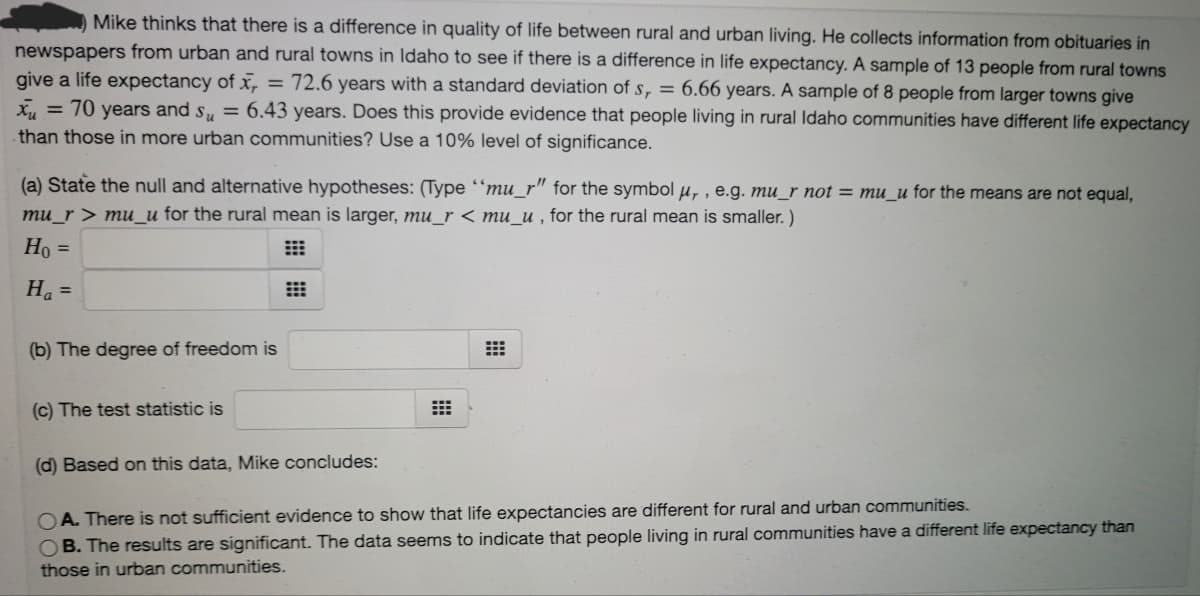ural towns give a life expectancy of x, = 72.6 years with a standard deviation of s, = 6.66 years. A sample of 8 people from larger towns give X, = 70 years and s, = 6.43 years. Does this provide evidence that people living in rural Idaho communities have different life expectancy than those in more urban communities? Use a 10% level of significance.
ural towns give a life expectancy of x, = 72.6 years with a standard deviation of s, = 6.66 years. A sample of 8 people from larger towns give X, = 70 years and s, = 6.43 years. Does this provide evidence that people living in rural Idaho communities have different life expectancy than those in more urban communities? Use a 10% level of significance.
Glencoe Algebra 1, Student Edition, 9780079039897, 0079039898, 2018
18th Edition
ISBN:9780079039897
Author:Carter
Publisher:Carter
Chapter10: Statistics
Section10.6: Summarizing Categorical Data
Problem 23PPS
Related questions
Question
See below.

Transcribed Image Text:Mike thinks that there is a difference in quality of life between rural and urban living. He collects information from obituaries in
newspapers from urban and rural towns in Idaho to see if there is a difference in life expectancy. A sample of 13 people from rural towns
give a life expectancy of x,
= 70 years and s, = 6.43 years. Does this provide evidence that people living in rural Idaho communities have different life expectancy
= 72.6 years with a standard deviation of s, = 6.66 years. A sample of 8 people from larger towns give
than those in more urban communities? Use a 10% level of significance.
(a) State the null and alternative hypotheses: (Type “'mu_r" for the symbol u, , e.g. mu_r not = mu_u for the means are not equal,
mu_r > mu_u for the rural mean is larger, mu_r < mu_u , for the rural mean is smaller. )
Ho =
Ha =
(b) The degree of freedom is
(c) The test statistic is
(d) Based on this data, Mike concludes:
OA. There is not sufficient evidence to show that life expectancies are different for rural and urban communities.
B. The results are significant. The data seems to indicate that people living in rural communities have a different life expectancy than
those in urban communities.
Expert Solution
This question has been solved!
Explore an expertly crafted, step-by-step solution for a thorough understanding of key concepts.
Step by step
Solved in 5 steps with 19 images

Recommended textbooks for you

Glencoe Algebra 1, Student Edition, 9780079039897…
Algebra
ISBN:
9780079039897
Author:
Carter
Publisher:
McGraw Hill

Big Ideas Math A Bridge To Success Algebra 1: Stu…
Algebra
ISBN:
9781680331141
Author:
HOUGHTON MIFFLIN HARCOURT
Publisher:
Houghton Mifflin Harcourt

Holt Mcdougal Larson Pre-algebra: Student Edition…
Algebra
ISBN:
9780547587776
Author:
HOLT MCDOUGAL
Publisher:
HOLT MCDOUGAL

Glencoe Algebra 1, Student Edition, 9780079039897…
Algebra
ISBN:
9780079039897
Author:
Carter
Publisher:
McGraw Hill

Big Ideas Math A Bridge To Success Algebra 1: Stu…
Algebra
ISBN:
9781680331141
Author:
HOUGHTON MIFFLIN HARCOURT
Publisher:
Houghton Mifflin Harcourt

Holt Mcdougal Larson Pre-algebra: Student Edition…
Algebra
ISBN:
9780547587776
Author:
HOLT MCDOUGAL
Publisher:
HOLT MCDOUGAL